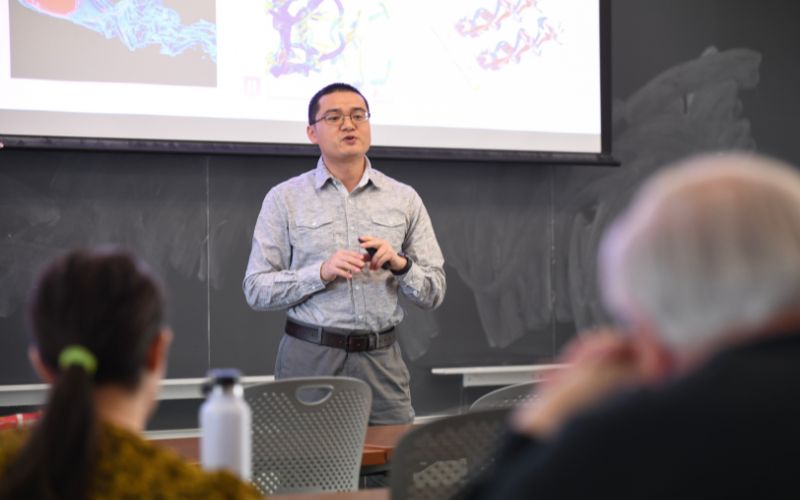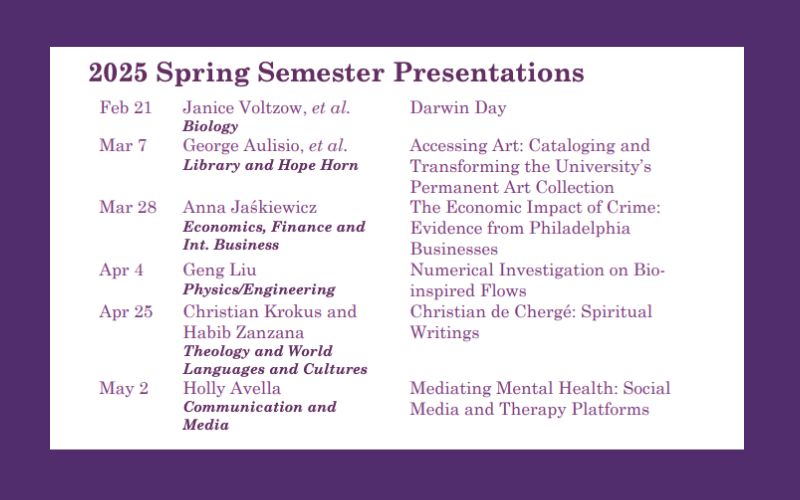Celebrating 20 Years of Faculty Research Seminars

Geng Liu, Ph.D., sees science in everything.
When fish swim and insects fly, Dr. Liu sees them lifting, pushing and flapping just as their bodies were naturally designed to do so.
As interesting as Dr. Liu finds the science behind those movements, however, he needed to tailor a recent lecture about it to people removed from this particular field of study.
So, Dr. Liu prepared slides with colorful GIFs and graphs, photos and videos, all embedded into a presentation for a general audience: his fellow University of Scranton faculty.
“Will you make screensavers?” asked one professor, mesmerized by the vibrant visuals swirling on screen. “I can watch this forever.”
Dr. Liu’s lecture was an informative and interactive hit, as have been hundreds of others in the Faculty Research Seminar Series, now in its 20th year.
Launched in February of 2005, the University’s peer-to-peer lecture series serves multiple purposes, including community building.
“The root of the word ‘college’ and the root of the word ‘collegial’ are the same,” said Stephen Whittaker, Ph.D., an English professor who’s attended the lectures for 20 years. “What that emphasizes is: the people who teach and do research and serve the mission, they thrive off of each other. They’re inspired by each other.”
Dr. Whittaker was one of about 20 faculty members — spanning all three colleges and a dozen departments — who attended the recent lecture by Dr. Liu, assistant professor of physics and engineering. Other lecturers this spring have come from the biology; library; and economics, finance and international business departments.
“We’re all teachers, we’re all lecturers and we all have that in common,” said Amelia Randich, Ph.D., assistant professor of biology. “But, it’s a different experience to hear a mathematician actually talk about what goes into years of work to prove a concept. Honestly, as an audience member, you still might not fully understand it, but you get an idea of the work involved and what they do.”
Dr. Randich is the coordinator of the series, a role she inherited this year from Declan Mulhall, Ph.D., professor of physics and engineering.
Dr. Mulhall and Jerry Muir, Ph.D., professor of mathematics, created the Faculty Research Seminar Series 20 years ago. The idea was formed in a mentorship program for first-year faculty such as Drs. Mulhall and Muir.
“We came to realize that a series of interdisciplinary talks would provide faculty an opportunity to make their work known to those outside of their departments and would serve the secondary purpose of breaking down misconceptions those in other disciplines have about the nature of work in their field,” Dr. Muir recalled.

It was an important undertaking, but a big one, too, especially since Drs. Mulhall and Muir were new to the University.
Dr. Mulhall had previously been at Michigan State, where, he said, research talks like this were the norm. He gave the first talk in Scranton’s series.
“I don’t know that either Declan or I saw this as ambitious at the time,” Dr. Muir said. “We were both new to the University, so maybe we didn’t appreciate where some pitfalls could have lain in getting this off the ground.
“It really came together quickly and, fortunately, there was a real appetite for something like this, leading to instant success.”
Dr. Randich was one of several speakers in February for a special presentation on Darwin Day.

Dr. Randich took a historical approach in her lecture, telling of the complicated relationship between Charles Darwin and Alfred Russel Wallace. While battling malaria on a remote Indonesian island in the 1850s, Wallace contacted Darwin with his research on natural selection, which helped influence the publishing of Darwin’s “On the Origin of Species.”
“I like to approach the Faculty Research Seminar from the point of view that you’re talking to a totally general audience who knows nothing about your field,” said Dr. Randich, who specializes in microbiology. “Even in my talk on my research, I used a lot of slides that I use to teach students about what viruses are, about what bacteria are. Your audience needs those fundamentals — but you can connect it to higher-level ideas really quickly because the faculty are prepared to think critically about everything. We often get really interesting questions.”
Some questions are serious and others are humorous. Occasionally, the lectures spark further collaboration and discussion among faculty.
One thing is a given at just about every lecture, though, and it’s been that way for 20 years.
“It is normal to leave the talks with a feeling of knowing the speaker better and having an appreciation of their field and contribution,” Dr. Mulhall said. “I’ve had a great laugh at least seven Fridays a semester and got to know a lot of my colleagues.”
All interested University faculty and staff are invited to attend this year’s final presentation on Friday, May 2, in Room 439 in the Loyola Science Center. Refreshments will be served.
For more information and if you’re interested in presenting a seminar in the 2025-26 academic year, email Dr. Randich at amelia.randich@scranton.edu.






